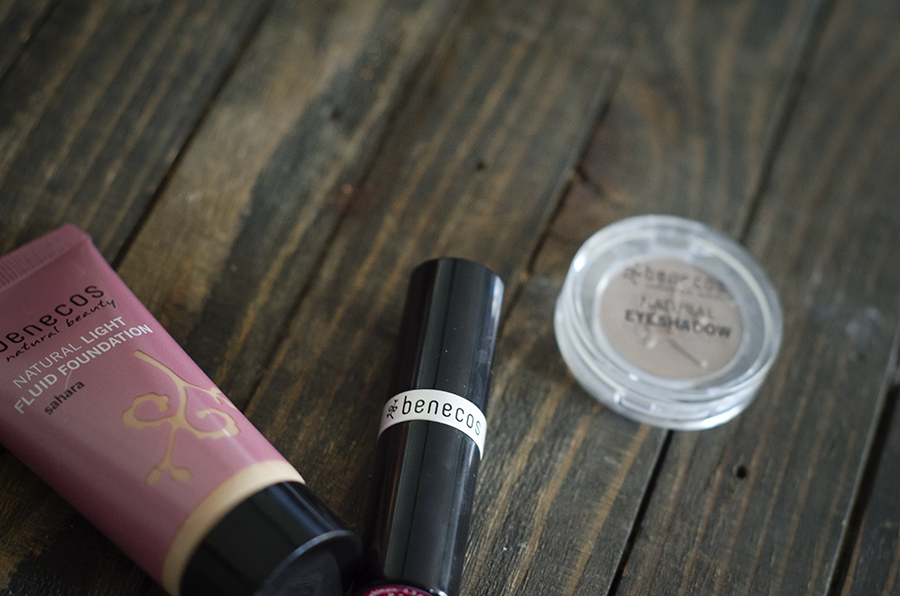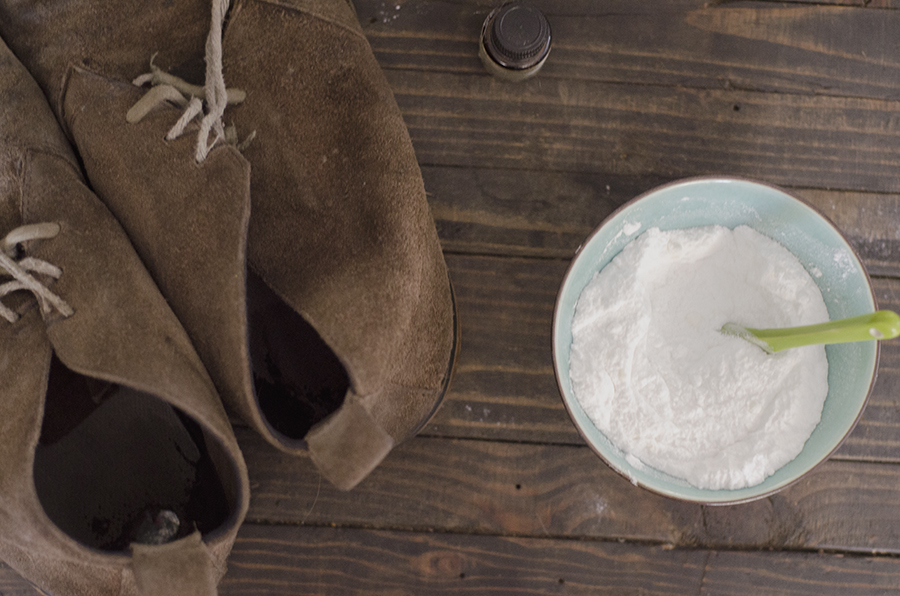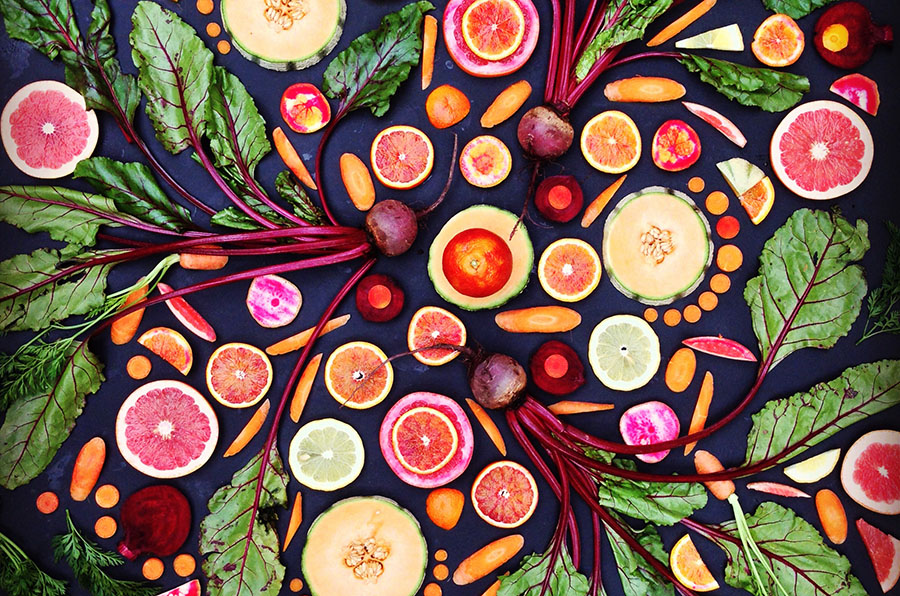Awhile back I posted about my post-pregnancy struggle with cracked heels and how a weekly Apple Cider Vinegar & Eucalyptus Foot Soak has helped me. While my feet have drastically, and I mean DRASTICALLY changed – my cracks were so bad they were painful and bleeding at times – I’m still on the warpath to baby soft heels.
I’m at the point where my feet are soft, with the faintest traces of lines, but if I stop moisturizing my heels for a couple of days I’ll start to see the lines deepen and begin hardening again. So clearly, soaking my skin till its spongy, scrubbing my heels raw and then slathering on artificial moisture isn’t going to cut it for an actual long term “fix”. I realized I need to get my skin to a place where it can do its job without me feeding it a jar of lotion every month.
So, as always, I became the great Google detective and tried to unravel this mystery of the perpetually cracked heels. And here’s what I found:
Cracked Heels Need To Be Treated From the Inside
Cracked heels occur when unhealthy dry skin around the heel responds to pressure from the weight of walking, or even standing, and the skin simply splits. It could be due to sudden weight gain (like pregnancy), skin that has lost elasticity with age, or just a result of ongoing dehydration.
To understand the problem with dry skin that won’t dehydrate with lotions alone, you have to understand the basic nature of the skin on your feet.
The outer layers of the skin on your heels are designed to provide a natural barrier function, which consists of substances such as oils, cholesterol, fatty acids, ceramides and hyaluronic acid. The stratum corneum, the very top layer of the epidermis on your heels, is made up of cells that grab water using your body’s own natural moisturizing factors, amino acids and other molecules that are designed to absorb water and lock it inside the cell.
Without your body producing its own natural moisturizing factors, it simply CANNOT maintain or absorb the moisture you feed it through foot lotions and oils. At least not in the long term. It’s like trying to pour oil into a cracked cup. You may be able to fill it to the brim (look how oily and shiny my feet are!) but it will all eventually seep out (why are my feet so dry AGAIN?!).
Anyway, the health of the skins natural barrier function is crucial to provide lubrication and protection to your feet. If the barrier becomes damaged or impaired, like in the case of cracked heels, dehydration results. So the only way to get rid of cracked heels for good is to rehydrate the skin – from the inside out. Here’s how:
Drink Lots Of Water
How It Helps – Sufficient water intake is critical in maintaining healthy cell metabolism. A dehydrated body can’t repair existing superficial epidermal dehydration. The fact is that skin is an organ, and just like any other part of the body, the skin on your heels is made up of cells. And skin cells, like any other cell in the body, are made up of water. Without water, the organs will certainly not function properly or at their best. If your skin is not getting the sufficient amount of water, the lack of hydration will present itself by turning your skin dry, tight and less resilient, which on your feet means lots of lovely cracks and fissures.
Other Health Bonuses – Drinking water helps maintain the balance of body fluids. Your body is composed of about 60% water and the functions of these bodily fluids include digestion, absorption, circulation, creation of saliva, transportation of nutrients, and maintenance of body temperature. It’s pretty much vital to life.
How Much To Drink – The unfortunate truth about drinking water and your cracked heels is that water will reach all the other organs before it reaches the skin. So if you are chronically dehydrated (*cough*me*cough*) you’ll have to really up your water intake to help your body regulate itself and hydrate your poor heels.
While the “8 cups a day” adage is under some debate – some medical professionals say you need less, some say you need as much as 9 to 13 cups a day – it’s best to err on the side of drinking too much water, especially when it comes to seeking tangible results in your skin. Aim for as much water as you can stomach. (It’s extremely hard to overdose on water. Most cases of water intoxication include athletes guzzling after a strenuous workout in the heat.) A good rule of thumb is to drink so much water that your urine has little to no color.
Take a Daily Multivitamin
Not only is this a good idea for your overall health, but multivitamins contain some heavy hitters in the healthy skin arena. Take a multivitamin that contains:
Zinc –
How It Helps – Zinc is a mineral that has been likened to a 24-hour, on-call skin mechanic. It helps repair damaged tissues and heal wounds. Without Zinc, your body’s (and your cracked heels) inside and outside repair time go up. Research suggests that Zinc is particularly effective in treating topical irritations such as cracked heels by helping the cells regenerate.
Other Health Bonuses- Consuming Zinc ensures proper immune system function, and promotes the maintenance of vision, taste, and smell.
How Much To Take – A daily multivitamin should have 100% or more of your daily requirement of Zinc (ranging from 11-50mg daily depending on who you ask), although you can also boost your Zinc intake by consuming oysters, red meat, poultry, seafood and fortified breakfast cereals.
Vitamin C –
How It Helps – Vitamin C, also known as ascorbic acid, is key to the production of collagen, a protein that aids in the growth of cells and blood vessels and gives skin its firmness and strength. Vitamin C also helps your skin repair itself – as an antioxidant it slows the rate of free-radical damage. Free radicals are unstable molecules that damage collagen and cause skin dryness and fine lines and cracks (like in your heels). New research shows that Vitamin C not only neutralizes free radicals, but also reverses DNA damage in some cases.
Other Health Bonuses – Vitamin C protects against immune system deficiencies, cardiovascular disease, prenatal health problems, eye disease, and even skin wrinkling.
How Much To Take – While a multivitamin usually contains 100% of your daily Vitamin C requirement (75mg to 120mg, depending on who you ask) Vitamin C is one of the safest supplements to boost up on – the safe upper limits being well over 2,000mg a day. Medical professionals recommend that when taking Vitamin C as a means to boost immunity or skin hydration, it’s best to aim for 500mg daily. I take an additional supplement of Vitamin C with Natural Rose Hips (extra antioxidant boost), in addition to my daily multivitamin.
Vitamin B6 –
How It Helps – Just like Vitamin C, B6 promotes healthy skin by counteracting damage caused by free radicals – molecules that break down healthy cells and contribute to aging and dehydration.
Other Health Bonuses – B6 stimulates co-enzymatic activities, protecting the immune system, and having positive effects on metabolism, premenstrual syndrome, hormone control and emotional disorders.
How Much To Take – A multivitamin should have 100% of your daily requirement of B6, ranging from 1.3 to 3mg, depending on who you ask. You can also boost your B6 intake by eating poultry, fish, and organ meats.
Increase Your Omega’s With a 3-6-9 Supplement
Omega 3, 6 and 9 contain essential fatty acids that are required for good health and hydrated skin, but cannot be synthesized by human body. They MUST be obtained from food or supplements. There are many over the counter supplements (often called 3-6-9 supplements) that cover all of your Omega needs in just one pill.
Omega-3 –
Among the must-have foods for healthy skin, Omega-3 fatty acids – the “good fats” – are well known for for promoting hydration and skin health. Omega-3 fats improve the moisture content of skin by improving cellular health and functioning, and help skin to maintain a smooth, elastic texture. Without essential fatty acids, too much moisture leaks out through the skin – for instance, the perpetually dry cracks in your heels. In short, taking Omega-3 internally as a supplement is as good as or better than applying cosmetic moisturizers.
Omega-6 –
Consuming oils rich in Omega-6 fatty acids can alter the fatty acid composition and eicosanoid content of the epidermis. Studies have shown that diets rich in the Omega-6 fatty acid linoleic acid are associated with less skin dryness and thinning. Both Omega-6 and Omega-3 polyunsaturated fatty acids play a critical role in normal skin function and appearance.
Omega-9 –
Omega-9, sometimes called oleic acid, aids in the proper functioning of the other necessary fats. If there is a deficiency in Omega-9’s, the other Omega’s can’t do their job properly. A deficiency usually manifests in dry skin, hair loss, and decreased fertility. If you are boosting your Omega-3’s and Omega-6’s, boosting your Omega-9’s is a must!
Where To Get Your Omega’s
Fish Oil – Fish Oil is a great source of Omega-3’s. In addition to promoting healthy skin, it also helps aid weight loss, promotes healthy pregnancy, fertility and boosts immunity. Regular consumption of Fish Oil capsules has been proven to help in reducing moisture loss from the skin.
Flaxseed Oil – Cultivated in Babylon as early as 3000 BC, Flaxseed Oil has been called one of the most powerful foods on the planet. In the 8th century, King Charlemagne believed so strongly in the health benefits of flaxseed that he passed laws requiring his subjects to consume it! A good source of both Omega-3 and Omega-6, preliminary studies show that Flaxseed Oil may help fight heart disease, diabetes and breast cancer in addition to boosting skin health!
Borage Oil – Borage Oil is derived from a wildflower commonly called the “starflower”. It is rich in Omega-6’s and is well known for its skin hydrating properties. A study by the Institute of Experimental Dermatology in Germany found that women who took Borage Oil supplements for 12 weeks experienced an overwhelming increase in skin moisture and hydration that exceeded that of drinking water alone. Borage Oil is also known to decrease PMS and menopause symptoms in women. Can we say win?
Evening Primrose Oil – A good source of Omega-3 and Omega-6, Evening Primrose Oil has been called the most sensational preventive discovery since Vitamin C. It’s most commonly known for it’s positive effects on women’s health, however the gamma-linoleic acid, linoleic acid and other nutrients in this oil are essential for cell structure and improve the elasticity of the skin.
Black Currant Oil – Black Currant Oil is an anti-inflammatory, antiviral and antioxidant. Rich in Omega-3 and Omega-9, this oil also aids immune systems, womens health and urinary tract health.
Be Consistent
These are the steps that I am personally taking to combat my dry, cracked heels from the inside out. I’m aggressively drinking as much water as I can stomach every day, I’m taking a daily multivitamin and I’m taking an Omega 3-6-9 supplement that contains every single one of the oils listed above. I’ve been at it for about three weeks now, and I’m seeing improvement every day, combining both internal and external approaches.
If there is an internal remedy or approach you take to cracked heels that I don’t have covered here (this is by no means an exhaustive list!) please let me know and share below!







I’m glad you are finally seeing the benefits of water! I know I don’t drink enough…it’s just so hard to do with my modified tummy. 🙁
I am still not drinking as much water as I’d LIKE to… coffee keeps getting in the way….
I carry a large water bottle with me everyday, otherwise I don’t drink nearly enough. It is tougher than it seems.
Right?! Whenever people get all tentative about drinking “too much water I’m like, ‘Da fuq?! How are YOU drinking so much that thats even remotely a problem?’ lol…
Are all of the oils listed above safe for BF? I took EPO at the end of my pregnancy since I was going for a VBac (successful! I might add) but I thought I remember that it couldn’t be taken when BF. Just wondering as I too suffer from cracked heals. Ugghh..only, I seem to not find the time to take care of myself these days.
I’m not sure if they are BFing safe.. I cannot produce any milk myself, and my daughter is being fed on breast milk donations. I would consult a doctor or Le Leche League… But I’d definitely look into it! I’ve seen a huge difference – mostly in my face – in regards to skin hydration since taking these supplements!
My feet always dry out in winter but I to would love for my feet to be baby soft!!!^_^
Thanks for the tips
No problem!!
I hope it’s working for you – please keep us updated. Other things to consider are whether or not it could be from a fungal infection (Athlete’s foot) or whether it could be from sensitivity (contact dermatitis) to some chemical in something your feet are frequently in contact, like in a carpet pair of shoes, etc.
Skin Disorders are found not only on face but on other parts too. They appear in the form of cracked heels which are painful and cause discomforts.
http://toptenstuff.in/ten-tips-to-cure-cracked-heels/
I finally broke down and bought an electric palm sander for my poor tootsies. I’ve used crushed asprin and lemon juice on my heels overnight. It kinda-sorta worked. I’m getting ready to try a banana-honey-lemon overnight foot mask. Anyone else heels itch under the heel callousness?
Can I ask which daily? And which supplement did you find that included all of those oils? Thx!
Thx for your work on this! I will begin this regimen to see how it works for me.
Also, I thought you’d like to know about this typo: “To understand the problem with dry skin that won’t dehydrate with lotions alone…” 🙂
I’m with you. The pedicure ladies always insist on grating my heals. They are AWFUL. I have got to get back to drinking more water. I was doing so well earlier this year.
I’m with Tracey. Please share which supplement you’re using that includes all the oils you recommend.
Thanks for all the great ideas!
Really useful, in my practice I observe that overweight people have cracked heel often. Your article is useful. I suggest all to read
Vitamin D pills plus Norweigian Heel Creeam have cured my heels.
Dr. Berg – vids available online – says that poeple can overdo drinking water. You acknowledged this caution, I noticed, so I took it a step further and discovered that it’s more than just a simple you-don’t-need-that-much. If in too large of amounts, your body is diminished in it’s vitamins and minerals. Dr. Bergman (different guy), who gives health videos online and has hordes of people coming to see him from all over the world, also says this. I mention it just as a caution, a check it out kind of thing, as I know none of us want to have expensive urine. Thanks for mentioning this caution – I’m glad to know all this info. Great info!
Nice way to cure cracked heels